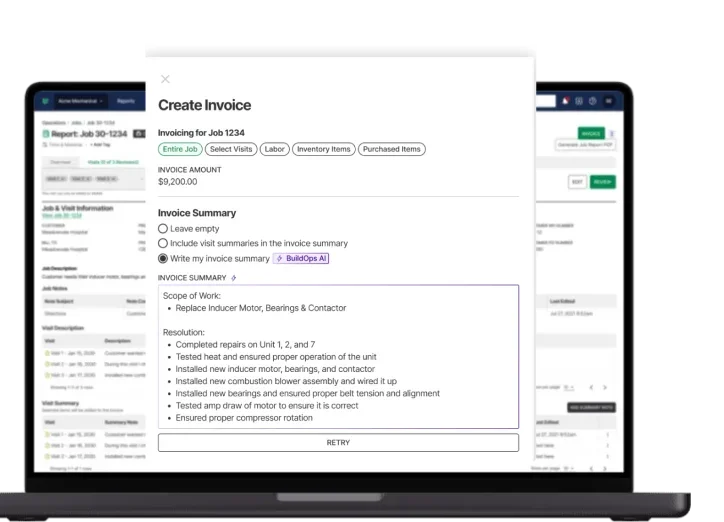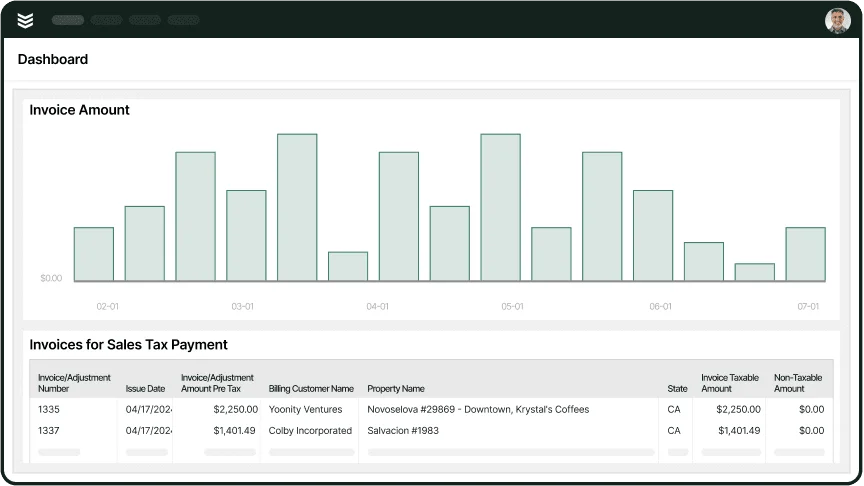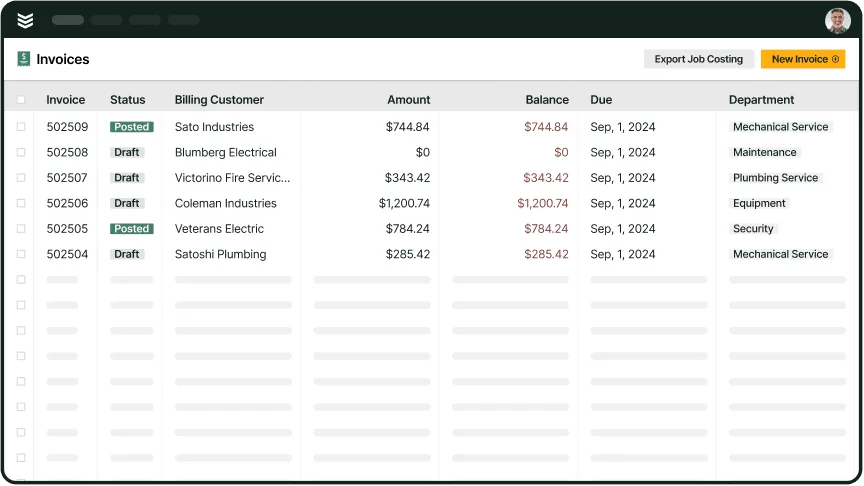When you’re out in the field juggling service calls, equipment, and client expectations, the last thing you need is a paperwork mess. A work order invoice keeps the chaos in check. It tracks what work was done, what parts were used, and what needs to be paid—so there’s no second guessing and no time wasted chasing down details. For service contractors, it’s a tool that turns the job into a paycheck, plain and simple—and a key part of any organized invoicing system that keeps everything flowing from job to payment.
Whether you're managing a crew or working solo, getting this document right can save hours, avoid disputes, and get you paid faster. Here’s what we’ll cover:
- What’s the difference between a work order and an invoice?
- What’s a work order?
- What’s an invoice?
- Who needs to use work orders and invoices?
- 6 best work order and invoice software & tools
- 7 benefits of using work orders and invoices
Each part of this guide is designed to help you tighten up your process, from job approval to final payment. Whether you’re looking to sharpen your forms, choose better tools, or just avoid the usual headaches—let’s get into it.
What’s the difference between a work order and an invoice?
A work order kicks off a job—it lays out the scope, labor, and materials before work begins. An invoice closes it out. It lists what was completed and what it costs. One authorizes the work. The other requests payment. Both are critical to running jobs clean, accurately, and getting paid on time.
Think of the work order as your job blueprint—it gets everyone aligned before tools come out. The invoice comes later, acting as your record of services delivered and a formal request for payment. Mixing them up leads to miscommunication, missed items, or delays in getting paid.
What’s a work order?
A work order is a document that outlines what needs to be done on a job—labor, parts, and tasks. It’s used to assign work, track progress, and create accountability. It’s typically created before the job begins and gives both your crew and the customers a clear breakdown of what to expect.
What do contractors use work orders for?
Contractors use work orders to lay out the job before anything gets touched. It’s how they assign tasks, list out needed materials, estimate labor, and document what needs to happen on-site. It gives the crew clear direction and protects everyone if questions or changes pop up mid-job.
It’s also a way to keep clients in the loop. When a work order is shared ahead of time, there’s less back-and-forth and fewer surprises when the invoice shows up. It sets the expectation early—what the job includes, what it might cost, and when it should be done.
Work orders also help teams stay organized in the field. Instead of relying on memory or scattered texts, techs can reference one document for what to do, where to go, and what tools or parts they need. It cuts down on mistakes, do-overs, and time lost on-site.
What’s an invoice?
An invoice is sent to a client after a job’s done. It lists the labor, materials, costs, and payment terms. The invoice serves as the official request for payment, turning completed work into revenue you can actually collect. It’s your go-to tool for closing out the financial side of any project.
What do contractors use invoices for?
Contractors use invoices to get paid for completed work. It’s the document that tells the customer how much is owed, what it’s for, and when payment is due. Without an invoice, payment can get delayed—or worse, forgotten.
They also use invoices to track income and job costs. Whether you’re billing a simple repair or a large multi-phase project, invoices help organize financials across jobs, clients, and timelines. It’s how you stay on top of cash flow and make sure no work slips through unpaid.
Invoices also create a record for accounting, taxes, and disputes. If a client ever questions a charge or if you need backup during tax season, your invoice becomes proof of what was done, when it happened, and how much was charged.

Take the guesswork out of invoicing
Learn real ways to tighten your invoicing process so you get paid faster.
Who needs to use work orders and invoices?
If you work in the field and get paid for hands-on jobs, you need both a work order and an invoice. One keeps the job on track, the other keeps the money coming in. These docs are essential across trades because they bring clarity—to your crew, to your client, and to your books.
- Plumbers: Plumbing professionals rely on work orders to track scope—leaks, installs, or repipes—and use invoices to confirm final charges for labor and materials after the job’s done.
- Electricians: With detailed steps and code compliance often involved, electricians use work orders to organize tasks and invoices to bill for time, parts, and inspections.
- HVAC: From diagnostics to installs, HVAC pros document the service call on a work order. Once systems are tested and running, they send the invoice to get paid.
- Fire safety: Fire protection contractors use work orders to document inspections, repairs, and equipment installs. Invoices follow to outline labor, parts, and compliance testing fees—critical for both billing and recordkeeping.
- Construction: For projects that span weeks or months, work orders track scope changes and daily tasks, while invoices break down progress billing or project phases.
- Landscaping: Work orders clarify recurring jobs or custom designs, and invoices help wrap up projects or log routine service for billing cycles.
- Pest control, property maintenance, appliance repair: Any field service that requires job tracking and post-service billing benefits from using both.
Whether you’re handling one-off repairs or managing recurring service agreements, using both a work order and an invoice helps avoid misunderstandings, delays, and missed payments. Now let’s look at the tools that can help automate invoices and simplify work orders.
6 best work order and invoice software & tools
Whether you’re running a growing service crew or managing multiple field teams, software can take the load off when it comes to organizing work orders and sending out invoices. Here are six top tools that help you get jobs on the schedule, track them through to completion, and close them out with clean, professional billing.
1. BuildOps
BuildOps is tailored for commercial contractors handling complex projects and recurring service. Its platform connects work orders, job tracking, and invoicing into one place—so everything flows from field to office without missing a beat. Work orders can be customized, scheduled, and assigned. Invoices are generated automatically with job data, cutting manual work and speeding up payment.
How Pricing Works: BuildOps offers custom pricing based on company size, trade focus, and feature needs. You’ll need to schedule a demo to get specific quotes.
What Sets It Apart for Work Orders & Invoicing: BuildOps is designed specifically for commercial contractors, not general field service. It supports multi-phase jobs, detailed asset tracking, and real-time field updates that directly inform invoices. That means less admin time, fewer errors, and faster turnaround from job to payment.

Want to see BuildOps in action?
Manage work orders effectively so you get more jobs done and increase cash flow.
2. Jobber
Image Source: Jobber
Jobber is popular among small-to-midsize field service companies. It offers an easy-to-use interface for creating work orders, managing jobs, and sending out invoices. You can create quotes, convert them into jobs, and send invoices directly from the mobile app—handy for teams always on the move. That said, it may not scale well for commercial contractors handling complex, multi-layered jobs or detailed asset management.
How Pricing Works: Starts at $29/month for one user, with plans going up to $169/month for full teams and advanced features.
What Sets It Apart for Work Orders & Invoicing: Jobber shines for its simplicity. It’s easy to learn, works well across desktop and mobile, and has strong automations like reminders and follow-ups. But it may fall short for larger commercial contractors needing deep customization, asset tracking, or multi-layer work order logic.
Expert Tip
If you’re running a smaller shop and looking for invoicing tools that won’t slow you down, check out our guide to invoicing software for small business and find a solution that actually fits how you work.
3. Datamoto
Image Source: Datamoto
Datamoto is a cloud-based tool designed for service teams and small manufacturers. It supports creating detailed work orders and tying them to sales quotes, inventory, and invoicing. It’s useful for teams that also manage parts or product delivery as part of their service. However, it may not be the best choice for contractors who need mobile-first features or robust field service dispatching.
How Pricing Works: Plans start at $49/month per user, with volume discounts available. Free trial is offered.
What Sets It Apart for Work Orders & Invoicing: Datamoto’s strength is its integration with purchasing and inventory control. You can issue work orders, manage parts, and invoice—all within the same tool. However, it may not be ideal for contractors needing mobile field access, on-the-fly scheduling, or commercial job management.
4. Fieldboss
Image Source: Fieldboss
Fieldboss is built on Microsoft Dynamics and caters to specialty trades like HVAC, elevator, and building services. It connects job tracking, invoicing, and customer data in one platform. The system supports complex workflows, recurring maintenance contracts, and multi-location service tracking. However, because it runs on Microsoft Dynamics, it can be too bulky or overwhelming for smaller contractors looking for quick setup and ease of use.
How Pricing Works: Custom pricing is available through consultation. Pricing depends on the scope of implementation and Dynamics 365 licensing.
What Sets It Apart for Work Orders & Invoicing: Fieldboss is strong on depth—especially for companies that need custom workflows and regulatory compliance. It handles recurring work, customer asset histories, and complex service chains, all while linking directly to invoice generation and follow-up.
5. Housecall Pro
Image Source: Housecall Pro
Housecall Pro is popular with residential contractors and small field service businesses. It lets you create and send work orders and invoices through a clean mobile interface. The app supports batch invoicing, real-time customer updates, and payments all in one place. But it may not suit commercial operations that need detailed scheduling logic or multi-tech job coordination.
How Pricing Works: Starts at $49/month, with higher-tier plans going up to $129/month for access to full features and automation.
What Sets It Apart for Work Orders & Invoicing: Housecall Pro is built for speed. You can dispatch, invoice, and collect payment from the field. It’s also customer-friendly, offering automated texts and email reminders. However, its simplicity can be limiting for contractors running large crews or managing service agreements.
6. Fiix
Image Source: Fiix
Fiix is a CMMS (computerized maintenance management system) tailored for teams managing asset-heavy operations. It lets you generate, track, and schedule work orders while connecting them to inventory and maintenance logs. Invoices are generated from completed work orders with clear time and material tracking. That said, Fiix is more industrial-focused and may not align well with traditional field service contractors or mobile crews.
How Pricing Works: Free plan available for small teams. Paid plans start around $45/month per user, with enterprise options available.
What Sets It Apart for Work Orders & Invoicing: Fiix is ideal for preventive maintenance and asset-heavy workflows. You can build custom work order templates, assign based on skill sets, and tie everything back to maintenance costs and invoicing. It’s especially useful in environments with recurring machine upkeep or facility service work.

Get paid on time—every time
BuildOps streamlines work order management and invoicing to keep jobs on track.
7 benefits of using work orders and invoices
Work orders and invoices aren’t just paperwork—they’re tools that keep jobs running, crews aligned, and cash flowing. Without them, it’s easy to lose track of what was done, what’s owed, and what’s falling through the cracks. When used together, they become the backbone of how field service work gets quoted, delivered, and paid for.
1. Fewer job site mistakes
When a crew shows up with a clear work order in hand, they know exactly what needs to happen—no vague instructions or forgotten materials. The work order lays out the scope, location, who’s assigned, and any customer notes or special requests. That kind of clarity prevents errors, reduces callbacks, and makes sure nothing gets missed when time’s tight. It works even better when paired with scheduling and invoicing software that keeps job details, timing, and billing all in sync.
2. Faster billing and payment
Work orders serve as real-time records of the job—what was done, how long it took, and what parts were used. When the job wraps, all that info flows straight into the invoice. Instead of waiting for techs to call in notes or office staff to hunt down job details, the invoice is ready to send same-day. That speeds up collections and gives your team more time to focus on the next job.
Deep Dive
Getting paid faster doesn’t just happen—it requires invoicing practices that help teams automate client billing and ensure speedy follow-up messages are sent. In the Invoicing Sweet Spot, we break down the optimal time to send invoices for best results.
Hint: if you want to get paid on time, you want to send them within 10 days.
3. Better team coordination
Dispatch creates the work order. The tech completes it in the field. The office bills it. Everyone touches the same document at different stages, and when the system works, nothing falls through the cracks. Tools built around field workforce management help pull this all together—linking schedules, work orders, and invoicing into one seamless loop that keeps field and office teams moving in sync.
4. Easier to track job costs
If you’re not logging labor and materials in real time, you’re guessing at your margins. Work orders track usage while the job’s happening. Invoices confirm what was billed. Together, they give you the full picture of how much each job costs you versus how much you charged. That kind of tracking helps you spot underpriced work, protect your margins, and price smarter on future bids.
5. Less admin work
Without a system, someone has to manually type the same info over and over—from quote, to work order, to invoice. That’s hours lost and mistakes waiting to happen. With digital tools, the job info flows automatically from one step to the next. Field service invoicing software lets you pull completed work orders directly into invoices with a click—no retyping, no chasing techs for details.
6. Stronger customer communication
Work orders and invoices make it easier to keep customers in the loop. Before the job, they know what to expect. After the job, they see exactly what got done and what they’re paying for. That transparency reduces disputes, increases trust, and makes clients more likely to call you back for the next project. You’re showing up organized—and it shows.
7. Tighter control of your operation
When every job flows through a consistent process—work order to invoice—you build a trackable, repeatable system. You can review job histories, measure crew performance, and catch patterns early. Tools like field workforce management software give you a bird’s-eye view of every open work order, outstanding invoice, and technician in the field. That control helps you grow without things falling apart behind the scenes.
Work orders and invoices might seem like small pieces of paperwork, but for contractors, they’re mission-critical. They connect the jobsite to the office, the crew to the customer, and the work to your bottom line. When you have a system that ties these tools together—from scheduling to job tracking to billing—you can stay organized, avoid rework, and get paid faster.
Most platforms out there cover part of the process—maybe dispatch, maybe billing. But when you’re running commercial jobs with multiple techs, assets, or service contracts, you need a system that ties it all together—including invoice automation that actually fits how your crews work. That’s where BuildOps stands out. It’s one platform built specifically for commercial field service, handling work orders, invoicing, and everything in between.

Curious if BuildOps is a good fit?
Run a tighter, more profitable operation with work order management.






